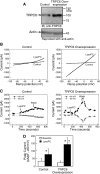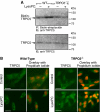Elucidation of a TRPC6-TRPC5 channel cascade that restricts endothelial cell movement
- PMID: 18495872
- PMCID: PMC2488296
- DOI: 10.1091/mbc.e07-08-0765
Elucidation of a TRPC6-TRPC5 channel cascade that restricts endothelial cell movement
Abstract
Canonical transient receptor potential (TRPC) channels are opened by classical signal transduction events initiated by receptor activation or depletion of intracellular calcium stores. Here, we report a novel mechanism for opening TRPC channels in which TRPC6 activation initiates a cascade resulting in TRPC5 translocation. When endothelial cells (ECs) are incubated in lysophosphatidylcholine (lysoPC), rapid translocation of TRPC6 initiates calcium influx that results in externalization of TRPC5. Activation of this TRPC6-5 cascade causes a prolonged increase in intracellular calcium concentration ([Ca(2+)](i)) that inhibits EC movement. When TRPC5 is down-regulated with siRNA, the lysoPC-induced rise in [Ca(2+)](i) is shortened and the inhibition of EC migration is lessened. When TRPC6 is down-regulated or EC from TRPC6(-/-) mice are studied, lysoPC has minimal effect on [Ca(2+)](i) and EC migration. In addition, TRPC5 is not externalized in response to lysoPC, supporting the dependence of TRPC5 translocation on the opening of TRPC6 channels. Activation of this novel TRPC channel cascade by lysoPC, resulting in the inhibition of EC migration, could adversely impact on EC healing in atherosclerotic arteries where lysoPC is abundant.
Figures








Similar articles
-
Integration of TRPC6 and NADPH oxidase activation in lysophosphatidylcholine-induced TRPC5 externalization.Am J Physiol Cell Physiol. 2017 Nov 1;313(5):C541-C555. doi: 10.1152/ajpcell.00028.2017. Epub 2017 Aug 23. Am J Physiol Cell Physiol. 2017. PMID: 28835433 Free PMC article.
-
Membrane translocation of TRPC6 channels and endothelial migration are regulated by calmodulin and PI3 kinase activation.Proc Natl Acad Sci U S A. 2016 Feb 23;113(8):2110-5. doi: 10.1073/pnas.1600371113. Epub 2016 Feb 8. Proc Natl Acad Sci U S A. 2016. PMID: 26858457 Free PMC article.
-
Activation of the cytosolic calcium-independent phospholipase A2 β isoform contributes to TRPC6 externalization via release of arachidonic acid.J Biol Chem. 2021 Oct;297(4):101180. doi: 10.1016/j.jbc.2021.101180. Epub 2021 Sep 10. J Biol Chem. 2021. PMID: 34509476 Free PMC article.
-
Canonical Transient Receptor Potential 6 Channel: A New Target of Reactive Oxygen Species in Renal Physiology and Pathology.Antioxid Redox Signal. 2016 Nov 1;25(13):732-748. doi: 10.1089/ars.2016.6661. Epub 2016 Mar 18. Antioxid Redox Signal. 2016. PMID: 26937558 Free PMC article. Review.
-
Balancing calcium signals through TRPC5 and TRPC6 in podocytes.J Am Soc Nephrol. 2011 Nov;22(11):1969-80. doi: 10.1681/ASN.2011040370. Epub 2011 Oct 6. J Am Soc Nephrol. 2011. PMID: 21980113 Free PMC article. Review.
Cited by
-
On the role of endothelial TRPC3 channels in endothelial dysfunction and cardiovascular disease.Cardiovasc Hematol Agents Med Chem. 2012 Sep;10(3):265-74. doi: 10.2174/187152512802651051. Cardiovasc Hematol Agents Med Chem. 2012. PMID: 22827251 Free PMC article. Review.
-
Properties and therapeutic potential of transient receptor potential channels with putative roles in adversity: focus on TRPC5, TRPM2 and TRPA1.Curr Drug Targets. 2011 May;12(5):724-36. doi: 10.2174/138945011795378568. Curr Drug Targets. 2011. PMID: 21291387 Free PMC article. Review.
-
Inhibition of endothelial cell Ca²⁺ entry and transient receptor potential channels by Sigma-1 receptor ligands.Br J Pharmacol. 2013 Mar;168(6):1445-55. doi: 10.1111/bph.12041. Br J Pharmacol. 2013. PMID: 23121507 Free PMC article.
-
TRPV4 participates in the establishment of trailing adhesions and directional persistence of migrating cells.Pflugers Arch. 2015 Oct;467(10):2107-19. doi: 10.1007/s00424-014-1679-8. Epub 2015 Jan 6. Pflugers Arch. 2015. PMID: 25559845
-
Endothelial Transient Receptor Potential Channels and Vascular Remodeling: Extracellular Ca2 + Entry for Angiogenesis, Arteriogenesis and Vasculogenesis.Front Physiol. 2020 Jan 21;10:1618. doi: 10.3389/fphys.2019.01618. eCollection 2019. Front Physiol. 2020. PMID: 32038296 Free PMC article. Review.
References
-
- Bezzerides V. J., Ramsey I. S., Kotecha S., Greka A., Clapham D. E. Rapid vesicular translocation and insertion of TRP channels. Nat. Cell Biol. 2004;6:709–720. - PubMed
-
- Boulay G., Zhu X., Peyton M., Jiang M., Hurst R., Stefani E., Birnbaumer L. Cloning and expression of a novel mammalian homolog of Drosophila Transient Receptor Potential (Trp) involved in calcium entry secondary to activation of receptors coupled by the Gq class of G protein. J. Biol. Chem. 1997;272:29672–29680. - PubMed
-
- Cayouette S., Lussier M. P., Mathieu E. -L., Bousquet S. M., Boulay G. Exocytotic insertion of TRPC6 channel into the plasma membrane upon Gq protein-coupled receptor activation. J. Biol. Chem. 2004;279:7241–7246. - PubMed
-
- Chaudhuri P., Colles S. M., Damron D. S., Graham L. M. Lysophosphatidylcholine inhibits endothelial cell migration by increasing intracellular calcium and activating calpain. Arterioscler. Thromb. Vasc. Biol. 2003;23:218–223. - PubMed
-
- Chaudhuri P., Colles S. M., Fox P. L., Graham L. M. Protein kinase Cδ-dependent phosphorylation of syndecan-4 regulates cell migration. Circ. Res. 2005;97:674–681. - PubMed
Publication types
MeSH terms
Substances
Grants and funding
LinkOut - more resources
Full Text Sources
Other Literature Sources
Molecular Biology Databases
Miscellaneous

